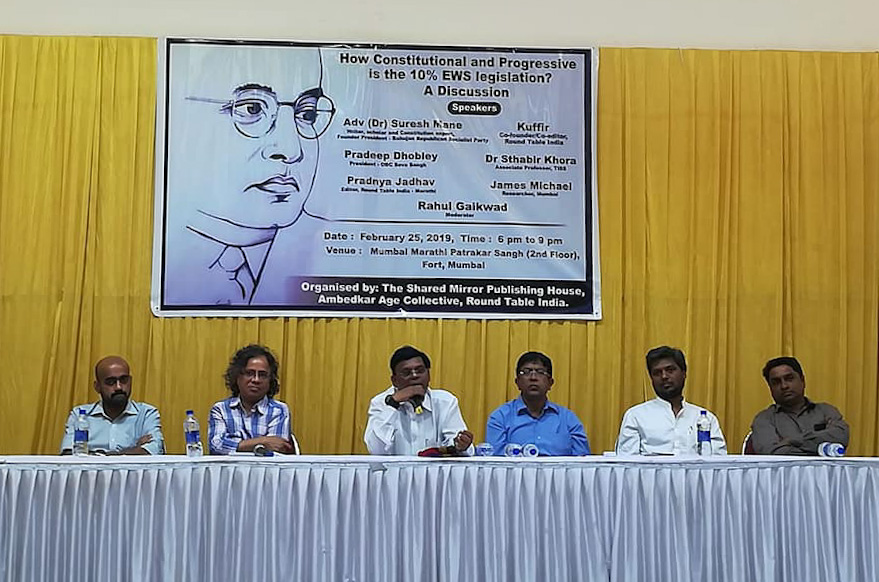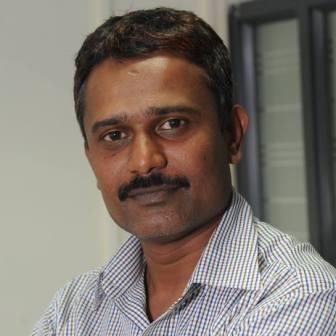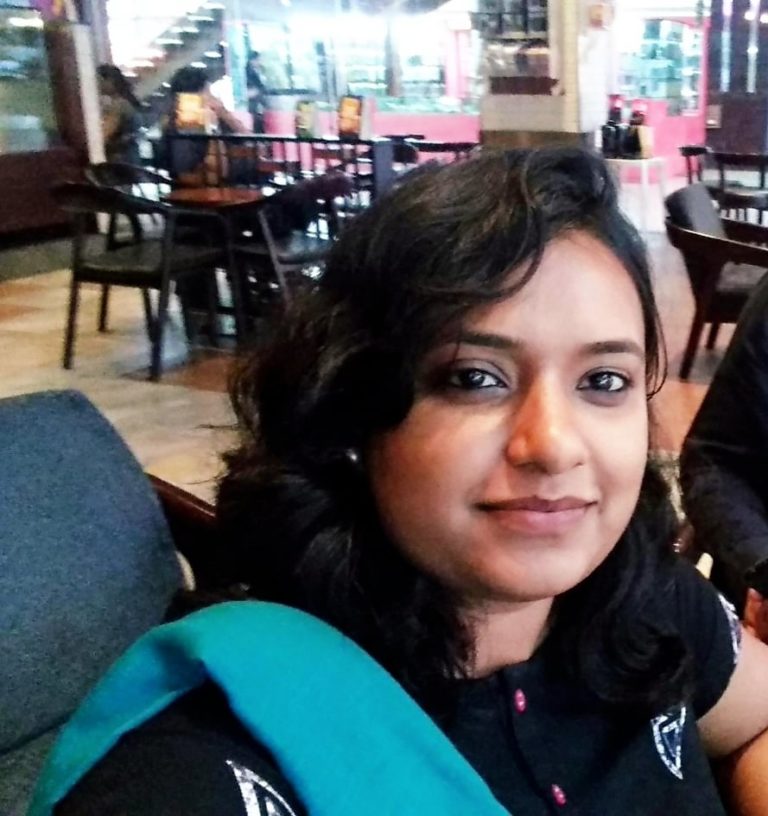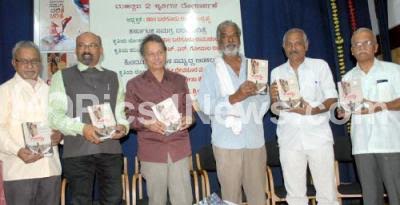Kuffir
(Transcript of his speech at the ‘Discussion on the Constitutionality and Progressiveness of the EWS Quota for the so-called Upper Castes and the Repercussions for the SC/ST/OBC/Pasmanda Representation‘ held on 25th of Feb, 2019 at the Mumbai Marathi Patrakar Sangh, Fort, Mumbai.)
Thank you. Jai Bhim. I have listened to all the speakers. They have all made very good points. I would like to briefly refer to some of them. There is not much time to speak more. Will start with what Prof. Sthabir Khora said, that facts and logic probably won’t make any sense to this judiciary. There was this piece of satirical writing by Philip Roth in the 70s. He referred to the ultra-conservatives in the Nixon regime. Nixon was referred to as ‘Tricky Dick’. They had created a new language (to suit their ultra right ideas). So they used to speak about the rights of the unborn. Here we are speaking of the ‘poverty’ of the Savarna, and as Mane sir said, something that doesn’t exist. The unborn have rights but those who are alive don’t have rights. The actual poor don’t have rights.

The problem with Indian politics & sociology is that we believe some classes are socially & educationally backward but they are not stigmatized. But where in the world is a poor man or socially or educationally backward man or a class or a group loved by the rest of society? There is a stigma attached to most of the backward classes as it is to the Scheduled Castes and there is a special kind of othering of the Scheduled Tribes. Let’s not group them together but let’s not forget the fact that Indian sociology is very very deficient. We forget the sociology of those who control Indian political science, and we keep assuming that this class will remain the same. Babasaheb and Marx said that things will change. They both said that change is the only permanent thing in the world. So this political class which has become a kind of common sense to us represents a certain kind of people (Brahmins and other upper castes) but we don’t see them as a class of people or certain caste/s of people. We have to change this, we have to change this political class.
In Indian parliament (Lok Sabha) right now, around 230 seats are occupied by the SC, ST, OBCs. 131 seats are reserved for SC/STs, OBCs obtained some 99 seats. Among these OBC seats there would be around 20 castes represented, out of a total of around 2500 OBC castes. So this is still a minority: 230, and we (SC, ST, OBCs) are supposedly the majority outside. But the actual majority in Indian parliament is around 310-320 upper caste occupied seats, purely upper castes across religions. But we still look towards the parliament to behave in a much more sensitive fashion than the judiciary. The independence of the Judiciary & social sensitivity of the Parliament: both are big jokes, they don’t exist. We keep believing it, era after era. But as Mane saab says, in essence, in certain cultural habits, ways of articulation & rhetoric, the political class doesn’t change. But the environment around them changes. I have a whole list of data which shows that until now in the parliament we have 35% representation of SC/ST/OBCs (and less many times, since the first Lok Sabha). This is the first pillar of our democracy. In the executive, we have 35-40% representation, much less most times. Not just in the Union Govt, but also in the the State Governments, our representation is less. Only nine State Governments out of 30 are run by OBC Chief Ministers. There is no SC or ST Chief Minister now. Twenty of them are run by upper castes. In the Centre, most Ministers are Brahmins, especially in the key portfolios, along with other upper castes. So this is the parliament, this is the executive.
When it comes to the Judiciary, it is God’s own divine secret: what is its composition. We see that lower judiciary has 30% representation or so of the SC/ST/OBCs. We don’t know about the Supreme Court and High Courts, they need not pay any attention to your RTIs or any other appeals. They don’t have to answer anyone, any citizen. They are outside the realm of accountability. So this is the third pillar, judiciary.

The fourth pillar we know. There have been two surveys, one in the 90s by BN Uniyal and then in the 2000s by Yogendra Yadav and others. Both have proved that SC/ST representation is near zero in National Media – Hindi & English. The OBC representation is around 3-4%. This is a fact that has not changed much. In fact, if there was objective research on what was the position of OBC representation in Central Government before the Mandal commission was promulgated, you will find that their representation has actually come down now. It has actually come down and their position is much more backward. In Public Sector Undertakings (PSUs) and Banks, their position is a joke actually speaking. The SC/ST positions are mostly in the Group C & Group D positions & posts.
So we are at this position and we can’t say politics should remain static. Even if it is static for the last 30-40 years, we can’t allow it to remain so. That would be very cynical of us (SC/ST/OBCs), you have been hit on the very spot where you live. This is the existential question. This might seem like, as Dhobley sir said, we seem to believe as common sense that there is a poor brahmin. The Bahujans are so generous that they will give anything for the poor brahmin and not do much even for their mothers, parents, and children. So this brahmin blindness and this generosity are so internalized that somehow we naturally tend to be generous, be liberal, be very considerate towards the upper castes. Where I come from (Telengana), we were not so very considerate and we followed a different path (during the Telangana Armed Struggle). Babasaheb clearly said, even when he was formulating the Constitution, and this is a very radical argument, he said when he was presenting the Constitution to the Parliament, “The principal aim of such a constitution must be to dislodge the governing class from its position and to prevent it from remaining as a governing class.”
{youtube}-IKkZ8DIKm0{/youtube}
This is very clear to me. And he referred umpteen times to the Brahmins as a Governing Class. We talk of 60-70% of Parliament, Central Govt Services occupied by the upper castes, but that is only partly right, it is mostly occupied by the brahmins. One friend told me that a Maratha acquaintance told him that this is a brahmin quota, he didn’t say it is upper caste quota. You see, they understand it quite plainly, the Patels, Marathas and the Kapus also understand it. The Jats also understand that this is going to be the brahmin quota. And like Mane Sir and Dhobley sir have clearly pointed out that jobs in the organised sector, which are the most prized jobs, which had a certain kind of security earlier–that has all disappeared. But despite that, you get a regular salary every month and that ensures 30-40 years of livelihood if you are in the Government service. In PSUs, you don’t know, you can be removed as well. There is no more security. It shouldn’t be called organized sector anymore. The private sector is another story, you can be retrenched in thousands. Despite that, the key question is not employment for the upper castes. They don’t want employment through it. So what do they want?
As I keep saying, the Marathas own 80% of agricultural land in Maharashtra, the agricultural land. Patels own 60-70% in Gujarat, Jats own 70% Punjab, Haryana. The Gounders (and other dominant castes) who were the cause of this 69% reservations in TN also own substantial extent of land there. They were removed by the Backward Class Commissions earlier from the list of Backward Classes. The Marathas’ appeal was rejected by the Backward Class Commissions. Same situation in Maharashtra, Tamil Nadu, and Karnataka. The Backward Class Commissions are hardly ever listened to. The Reddies and Velamas own 70% land in Telangana. The Kapus, Kammas, Reddies and the Rajus own 70-80% land in Andhra Pradesh. In every state, 2-3 castes own the the biggest chunk of land. And they are not doing much with it. This is the root of the material stranglehold of the upper castes on Indian society. I was just listening to a news program in Andhra, if there are 2500 acres in a village, only 700 acres belong to the actual tillers. The rest of the 1800 acres are again tilled by the tenants. They are mostly OBCs and Dalits now. That is the position of agriculture in India. 90% of these people are tenant farmers because they own an acre, they take 5 more acres on lease, they suffer losses and they die. Their death and their distress are guaranteed. That is the only thing that is permanent.
The point of the upper castes still retaining that land in the villages, especially in the highly educated southern states, where literacy levels are very high (in Andhra especially), and Kerala, Tamil Nadu, Karnataka needs to be looked at closely: why do these upper castes retain the land? Why do the Nairs retain the land in Kerala? Why do Reddies, Velamas still retain land in Telangana? Because the point of caste is that, the upper castes own something that you will never own. His own cultural and social status depends on his owning something, even if it is 20 acres of land which is fallow, but you guys don’t have any land and that is his pride. That is what ensures his status. So that is also why they don’t want us in this kind of permanent, secure jobs which would make them feel that we have moved into modernity very suddenly, from the middle of tilling in the fields, from doing artisanal work, from doing all kinds of impure work, which even if we are the best of craftsmen, even if we are scientists (as Kancha Ilaiah keeps saying), it doesn’t work (in elevating our status). Only if you wear a suit or a tie and you go to a factory or sit in a government office, only then you are supposed to be modern. (I keep saying that the Bahujan woman was the first mathematician in India. She discovered zero when she was planting rice saplings in a row.) We have internalized this hierarchy in our mind. But the brahmins and other upper castes know quite well that it doesn’t matter to them even if they get any new jobs through this 10% quota or not. What they want to ensure is that you don’t enter into these ‘modern’ spaces!
In universities, especially central universities–this is from the status of All India Survey of Higher Education Report (AISHE) from 2 years ago–only 23% students are from SC/ST/OBC. And these figures, all Government of India figures, hide a lot. Giving the benefit of doubt, we can say that at best we are 20 percent in Central Universities. This is our students, not the faculty. The faculty is 95% Brahmin-Savarna. So 20% students who are SC/ST/OBC get to enter these IITs, IIMs, etc. These upper castes want to add another 10% to their own quota, the ‘General Category’. As James Michael said, it is savarna quota, it is not distributable. It is an unwritten law, but as good as a written one on stone, that the 50% General Category belongs to the upper castes. Across South India and in other places, now the cutoff criteria for SCs and OBCs are generally higher than that of General Category. So they don’t want us in these Central Universities. To stop even the 20% of SC/ST/OBC inflow into the Central Universities, they have to bring in this 10% EWS. And our students by default–we are all poor, we can’t go to any private universities. So private universities are being manufactured to give employment to upper caste scholars. And they will give direct employment to upper caste scholars who earn their PhDs outside the country. So this is a kind of ancient spite. This is about social status and not about neo-liberalism or whatever. India follows this caste mode of production wherein upper castes have to control all kinds of means of production, whether it is the bail-gaadi or the nuclear reactor. And they have to control all kinds of consumption also. We, Bahujans, might produce the best of basmati rice in the world but 99% of it is consumed by the upper castes. We might produce the best of spices in the world, but it is the upper castes who have to consume it.
This (10% EWS) is a kind of a watershed event, much more watershed than when they turned Mandal into a joke. Now they have turned the whole Indian Constitution into a kind of a dud argument. You can’t base your politics purely on the basis of legalities and technicalities. Let’s go back to the basic idea Babasaheb referred to when he inserted these words ‘Liberty, Equality & Fraternity’ in the Indian Constitution. Let’s go back to these basics. The Preamble to the Indian Constitution says ‘We, THE PEOPLE OF INDIA, having solemnly resolved to constitute India into a SOVEREIGN SOCIALIST SECULAR DEMOCRATIC REPUBLIC and to secure to all its citizens; JUSTICE, social, economic and political’. Now this is impossible.
JUSTICE, social, economic and political: when 90% of the judiciary is upper caste, then how is this possible? And it is not in isolation. The composition of the Parliament, the Executive and the Media again will ensure that the Judiciary will remain only this, only upper caste.
‘LIBERTY of thought, expression, belief, faith and worship; EQUALITY of status and of opportunity; and to promote among them all FRATERNITY assuring that…’ What kind of Fraternity will be there when my Brahmin friend’s father is a High Court Judge and mother is the Chief Doctor in the best Government Medical School and his brother is in Silicon Valley, California whereas my father and mother didn’t even study second class? Is it natural to expect fraternity from people who are so very superior to you, if you can consider these kinds of things as marks of superiority. If they have crores and you have only thousands and you have to look for your wages every day, what kind of similarity, fraternity can be there between these kinds of people? What are we expecting?
There needs to be a rethinking, again going back to Babasaheb, asking what do Equality, Liberty & Fraternity actually mean. And we want them. So there is a need for SC/STs/OBCs to come together to fight. There is a common enemy. He occupies 70-80% of the best of positions, opportunities and material resources in the country and controls the best of the modern institutions which produce the most wealth. And also consumes the most wealth. So there is a clear enemy, the upper castes headed by the brahmin. You do whatever you want to, but don’t pass this off as a normal kind of politics and normal kind of justice issue or normal kind of legal issues.
Thank you. Jai Bhim!!
~~~
Speech transcribed by Vinay Shende, who works in the corporate sector and is interested in anti-caste thoughts and ideas.










